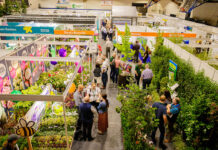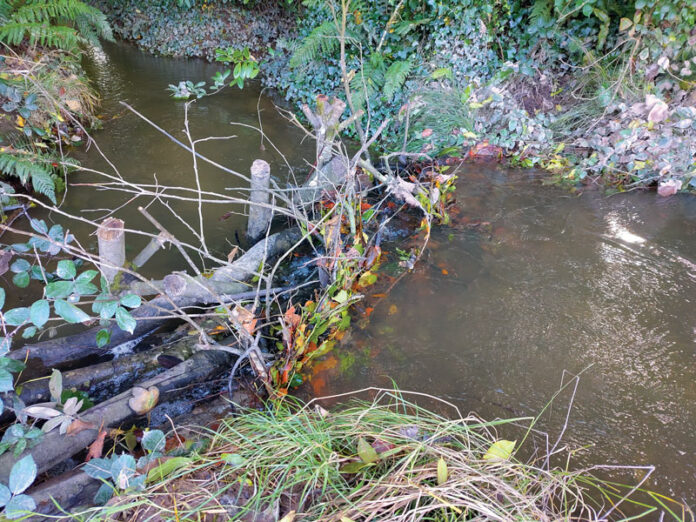

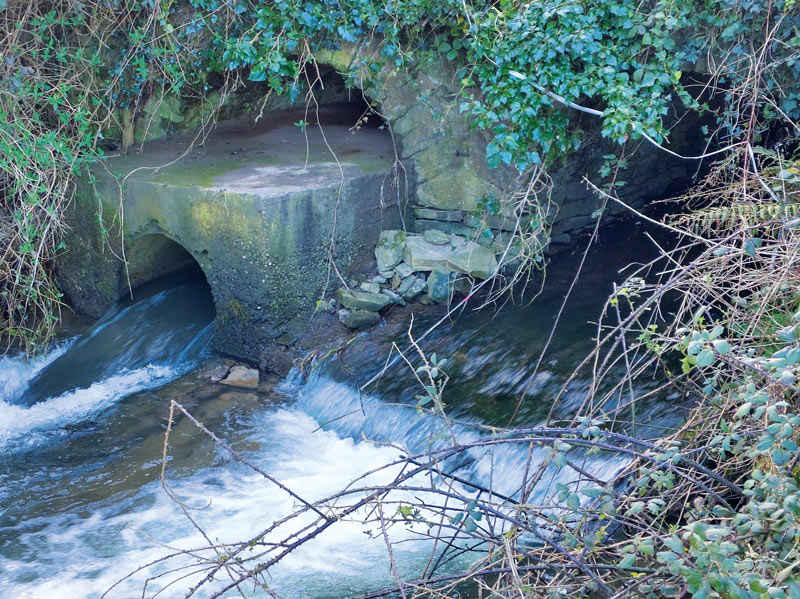 Without wanting to overstate the obvious: beavers are amazing landscape engineers. For those new to the subject, these small, vegetarian, water-loving animals play a role within the landscape that is way above what you’d expect from their shy, secluded demeanours.
Without wanting to overstate the obvious: beavers are amazing landscape engineers. For those new to the subject, these small, vegetarian, water-loving animals play a role within the landscape that is way above what you’d expect from their shy, secluded demeanours.
The dams that beavers build in rivers and streams are just the right design for flood prevention; holding water during downpours and then allowing some leakage through during drier weather for some drawdown of the stored reservoir. This provides the available space for storing the next flood that comes along. In this way beavers provide invaluable flood prevention within the catchment.
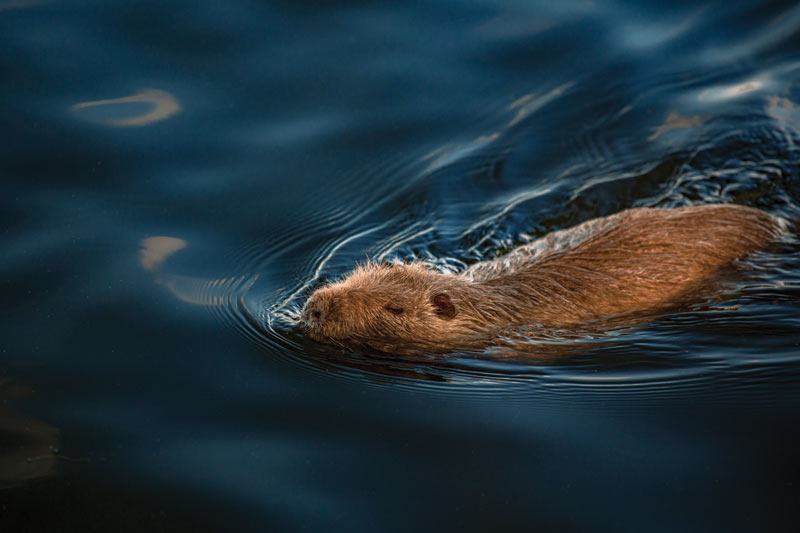

The flip side of this of course is that they also help to prevent waterways from drying up. This generally doesn’t pose much of an issue for people in the Irish context, where we consider an extended spell of dry weather a distinct boon.
However, when I interviewed the fish for this article, they said that they were “rightly peeved at human behaviours that exacerbated drought conditions in their home”. What to us is a pleasant dry spell, is to the fish a potentially life-threatening lack of habitat and water quality.
In addition to addressing the twin challenges of flooding and droughts, beaver dams also help to filter water as it passes through the catchment. The still water of the beaver pond provides excellent settlement space for silt and debris that may wash in from upstream. The plants that can be established around the pond perimeter provide uptake of nutrients.
Any excess pollution within the water has time to slow down and interact with natural physical, chemical and biological processes in the pond. These characteristics help to filter the flow and improve water quality as the rain makes its way from field to stream to sea.
Ponds and wetlands in general provide an amazing space for wildlife. Predictably, the ponds and wetland fringes that beavers create fulfil that role perfectly. While siltation and obstacles may pose challenges for fish, beaver dams have also been shown to have a beneficial impact on fish stocks overall, due to increased habitat for both fish and the insects they feed on, among other factors.
From a climate perspective, beaver dams not only help to address the flood/drought cycles associated with climate change, they also act as effective carbon sinks and stores within the landscape. As well as this, dams assist with groundwater recharge, helping to refill underlying stores of water; and in drier climates, they act as effective fire breaks for wildfire control.
The role of beavers in Ireland could be readily justified under our EU and international climate obligations, our water quality legislation, or as a much needed flood control measure – quite apart from the sheer wonder of watching beavers play out their natural role in the landscape.
Whether beavers were in Ireland historically or not is a subject that is debated amongst ecologists here. Ireland is within the climatic zone that beavers inhabit within Europe, Asia and North America, so if they were not here historically, it was due to rising sea levels after the last ice age rather than the unsuitability of climate or habitat. Although there are no fossil records in Ireland, the absence of evidence for beavers is not the same thing as evidence of absence.
Beavers are not a particularly contentious species introduction. The role for flood prevention and habitat creation could be immense
Another, arguably more appropriate discussion is whether beavers would work in the Irish context as a way to help address flooding, droughts, water quality, biodiversity losses, species extinctions, wetland habitat erosion and both the symptoms and causes of climate breakdown. The answer on all counts is a resounding YES!
CHALLENGES
There are of course drawbacks to any new endeavour. Most notably the potential for localised flooding behind dams, silting of fish-spawning beds, obstacles to fish passage, damage to farmland and in particular, to trees. To overcome these potential issues, ‘beaver deceivers’ can be used to limit flooding by placing a throughput pipe at strategic locations to protect buildings, for example. The potential damage to farmland is best addressed by fully acknowledging the multiple benefits of beaver habitat and paying a premium to land owners with beavers on their patch. Another mitigating method, when the above are insufficient, is relocation of beavers from unsuitable locations to better spots where their input is actively needed.
AND THE NEWS JUST IN . . .
A welcome development is that the Department of Agriculture has recently launched their ‘Forests for Water’ grant funding, which could become part of a suite of riparian woodland
funding going forward. Such funding would pave the way for beaver reintroductions in a number of ways. Land owners would already be funded for native tree planting along waterways, where water quality benefits are the main emphasis rather than obtaining a commercial timber yield. Hence there would be suitable habitat and food available for beavers, which is absent from many riparian habitats at present. Also, the flooding of land
would be less problematic because the trees would already be grant funded and would not be providing a crop of vegetables or grazing land. So the structures are already in place for a much wider spread of suitable beaver habitat within Ireland.
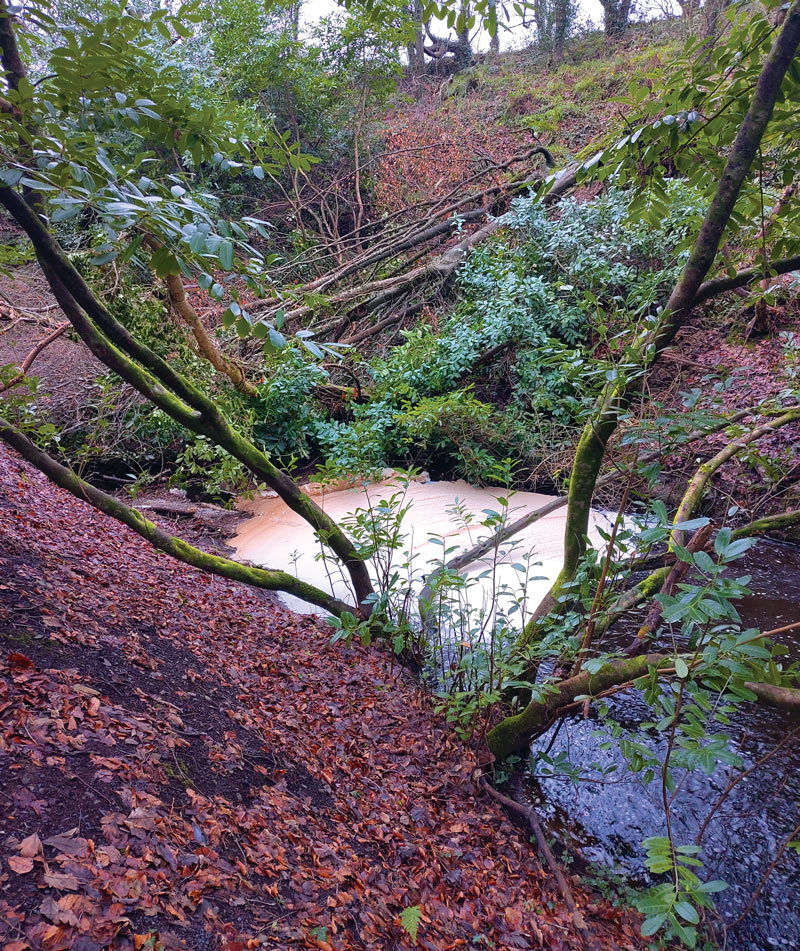

While there will be a few years before thickets of willow, birch and alder spring up, we can still look for suitable sites for beaver reintroductions within existing riparian woodland. There are also ways we can learn from beavers and the general principles of waterway rewilding (without going through the paperwork that would be required for a full scale reintroduction process in Ireland).
Dams, ponds and filtration are the three keywords here. Beaver dams work as leaky dams rather than hard weirs, and as such store flood water and release it slowly. This role can be emulated in a whole variety of ways with a combination of soft engineering and strategic planting.
Leaky log dams and brash dams are the initial tool to be used in the upper catchment. The log dams are typically built above normal flow levels, and come into effect when there is a rush of water. Leaf litter and debris catches on the upper side of the logs, slowing the flow velocity and easing pressure on downstream waterways and structures. Brash dams are made of bales made of heather, rushes or similar loose material which can act as a natural filter. These work in the smaller upland channels, holding back water in drains and streams, catching silt and sediments, slowing the flow and storing water in the upland areas where there is ample space.
More specifically, BDAs (Beaver Dam Analogues) and PALS (Post Assisted Log Structures) both overtly replicate the role of the beaver in creating in-channel structures; often as an
invitation to beavers to continue the work themselves once suitable habitat has been created.
Ponds and wetlands can be used in the lower catchment areas, holding onto stormwater during high rainfall and releasing this more slowly into the river system via controlled outlets. Many SuDS (Sustainable Drainage Systems) work on this principle, but for maximum filtration and habitat benefit, lean towards planted systems where possible, rather than concrete or plastic containers. The habitat value of ponds is enormous, so this biodiversity benefit of beaver dams can actually be replicated anywhere, whether within a stream channel or an urban garden. The principle of holding water and providing habitat for insects, birds, plants and other wildlife is the same regardless of which species builds it.
Filtration and water quality improvements may be achieved in a variety of ways: from high standards of sewage treatment for domestic septic tanks and municipal treatment systems, to proper containment and management of farmyard slurry and runoff.
It’s always a bit of a shock to look at the number of Irish towns and villages with nothing but primary settlement in a septic tank; particularly when it is simply a matter of prioritising budgets in the right direction. It shows how little we have valued clean water and aquatic biodiversity in the past. On our farms we can use riparian buffer zones, in-channel ponds and wetland planting within farm drains, wetland filters for farm road runoff, willow infiltration areas for yard runoff and other measures. These can all replicate the filtration role that the beavers offer in streams and rivers.
Within the fields themselves, farm scale composting is an amazing way to address water pollution issues within farming catchments. Compost is a stable form of nutrient cycling that keeps the nitrates and phosphates available for crops, rather than loosing them into waterways as pollution. Compost also holds up to 20 times its weight in water, so it can act as an incredible tool for flood prevention if used on farmland across an entire river system.
Another method for holding onto our soils is peatland rewetting; or, more accurately termed, groundwater level control. On peat soil grassland this involves raising the water table to within 40 cm of the ground level. This holds the carbon in place lower down, preventing the ongoing losses of the carbon into the atmosphere as happens on drained peats; thus saving soils and reducing climate change.
On a wider scale, re-flooding of cutover bogs is another beaver type endeavour, helping to restore habitat for a rich suite of Irish species. There is a growing hunger for rewilding of our river systems, as we see an increasing number of examples where nature has, unsurprisingly, done a better job of managing soil health, water quality, biodiversity protection and climate regulation than we have. There are often tourism or other economic benefits to boot.
MOVING FORWARD
So let’s start where we are. In the absence of beavers, we can create all of the filter measures described here on our farms, and build rich soils with compost in our fields. We can implement SuDS systems in our urban communities and prioritise maximum quality sewage treatment. In our homes we can plant willows below percolation areas that may be performing poorly (keeping the roots well back from the piping), and dig ponds in our gardens, parks or farms. There are many places to start, and no reason to stop after the first achievement. Instead we can keep moving towards ever greater richness and diversity of aquatic habitats in our local area.
We can work towards the (re) introduction of beavers. There is plenty of suitable habitat already for an initial introduction process. Beavers are not a particularly contentious species introduction. We’re not haggling over wolves or bears, which we know to have been native to Ireland. The benefits for flood prevention and habitat creation could be immense. There is also the thrill of watching a new species settle into its new home and begin to weave its magic in the landscape for the benefit of so many other species that share the space. Let’s not delay. Let’s put beavers on our list of favourite animals of the Irish countryside. ✽


FÉIDHLIM HARTY is a consultant beaver, advising on pond building, dam building, waterway rewilding, waterway filtration and riparian habitat repair. For upcoming workshops, visit www.wetlandsystems.ie.



